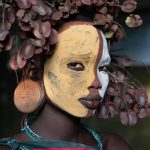Why do the Mursi or the Suri tribes adorn themselves with lip plate?
January 13, 2022
Visiting the Omo valley can feel like a journey through time, arriving at something as close as there is to an untouched Africa free from outside influences. There are thousands of Omo pastoralists, cultivators, and hunters who still live almost exactly as their ancestors did hundreds of years ago. Possessing few items from the modern world, the men, women, and children here ritually adorn themselves to express status and tribal identity.
However, the use of large lip plates is the most visible distinguishing feature of the Omo tribes.The Mursi tribes, along with the neighbouring Suri tribes, are believed to be the last groups in Africa where women still wear large pottery or wooden discs.
In this society, as girls reach puberty, they will have their lips cut and a small wooden plug inserted. Once the lip has been cut and stretched over a one-year period by inserting bigger and bigger wooden plugs, and then progressively larger lip-plates made of either clay or wood.
The question lies in the purpose of adorning oneself with lip plate.
The theory is that, it was historically a means of making women less appealing to slave traders. The suri or mursi do not acknowledge such a historical explanation. Another explanation suggests that the plate’s size indicates the number of cattle paid as the bride price. But the mursi and suri do not directly correlate the size of the lip-plate with the quantity of a woman’s bride wealth. The amount of bride wealth to be paid by their husbands’ families has been set before their lips are cut, or even before they are born.
In musi or suri cultures, wearing a lip plate is best regarded as an expression of social adulthood and reproductive potential; once a girl gets her lip pierced, it marks the transition to full womanhood, which is closely associated with fertility and marriage eligibility. Lip plates are a higher form of aesthetic expression; women with lip plates are frequently admired for possessing all the graces associated with womanhood, such as being calm, quiet, and hardworking, and, most importantly, for walking tall and proud in public, especially in the presence of men.
As a powerful visual marker of mursi or suri identity, a woman who does not have a pierced lip risks being mistaken for a member of one of their immediate neighbouring tribes, such as the Kwegu, Bodi, or Kara tribes. On occasions such as important ceremonial or ritual events like weeding, stick fighting, or childbirth, women are expected to wear lip plate. As a symbol of respect, a lady is always supposed to wear a lip plate when serving coffee or food to her husband or a guest in the home. Young girls with larger lip-plates may also wear them in public, such as when collecting water, traveling to the market, or visiting friends.





